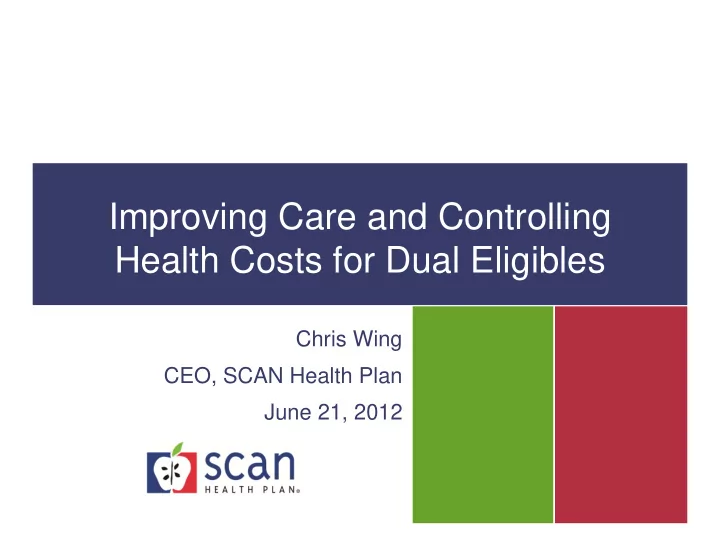

Improving Care and Controlling Health Costs for Dual Eligibles Chris Wing CEO, SCAN Health Plan June 21, 2012
SCAN Health Plan • Founded in 1977 by senior citizen activists frustrated by lack of access to appropriate services • Model of Care emphasizes prevention, early intervention, and providing right care at right time • State Social Case Management Waiver Programs • Two decades in CMS’ Social HMO Demo • Has successfully delayed or prevented 100,000 nursing home admissions in California
Current Operations • Nation’s 5 th largest not-for-profit MA plan • Approximately 130,000 Medicare beneficiaries • Nearly 8,000 California dual eligibles in D-SNPs, I-SNP, and other MA-PD plans • Awarded a 4-star MA quality rating in California • Manager of California’s largest MSSP site since 1980 • Has state MediCal contact to provide LTC services and support
Dual Eligibles at a Glance
Dual Eligibles at a Glance
SCAN’s Dual Eligibles • HEDIS scores for most duals = 75 th - >90 th percentile • Less than 2% of NFLOC membership are enrolled in LTC institutions • More than 96% of SCAN members with six or more chronic conditions currently live at home • NFLOC members average less than 12% acute hospital readmission rate • USC found a 26% greater likelihood of discharge from SNF to home through SCAN HCBS (avoiding conversion of short term to long term stay) • More than 96% of SCAN’s dual eligible members say that they are satisfied with their benefits
Low Disenrollment Rate Disenrollment SCAN FIDE-SNP SCAN Network Average - MAPD Voluntary 11.5 8.9 Involuntary 8.7 6.8 Total 20.2 15.2 * The national voluntary disenrollment rate for dual eligibles was 17% in 2003 (the last year that this data was collected).
Reduced Hospital Admissions SCAN/HCP FIDE-SNP Milliman LA County LA County* FFS Duals 285 458 Admits/1000/Year Avg Length of Stay 3.2 7.3 912 3342 Days/1000/Year * Source: 2011 encounter data Data is not case mix adjusted
Lower Nursing Home Admissions SCAN Network Average Milliman LA County – FIDE-SNP* FFS Duals .016% .06% Duals in LTC * Source: 2011 encounter data Data is not case mix adjusted
Avalere Study: Methodology • Released April 2012 • Looks at California individuals who were dually eligible in 2009 and 2010 • 5,500 SCAN duals and an equivalent number of duals enrolled in FFS Medicare • Risk profiles were matched to ensure accurate comparison • Examined hospitalizations and HEDIS 30-day all-cause readmissions rates • Performed rough estimate on Medicare savings rate
Avalere Study: Key Findings • Overall, SCAN performed 14 percent better on initial hospital admissions • Overall, SCAN performed 25 percent better on hospital readmissions • SCAN had lower rates of hospitalization for 9 of 12 measures comprising the PQI composite • SCAN had lower rates of observed readmissions and risk adjusted readmissions for all 12 condition groups measured • Avalere estimated at least $50 million in potential annual savings to Medicare in California
Avalere Health Study: Risk-Adjusted Readmission Rate
Implications for Duals Reform • Evidence shows integrated care is succeeding • State and federal governments should press forward with the dual integration demo • But the demo should not inadvertently undermine Special Needs Plans • States should contract with SNPs for LTC • Congress should extend the life of SNPs • PACE should be expanded beyond bricks and mortar and to younger populations
Appendix
Avalere Health Study: Hospitalization Rate
Avalere Health Study: Risk-Adjusted Readmission Rate
Further Discussion Peter Begans SVP, SCAN Health Plan 1101 Pennsylvania Ave NW Washington, DC 20004 202-756-2279 (office) 202-330-2903 (mobile)
Recommend
More recommend